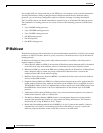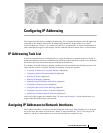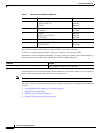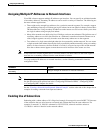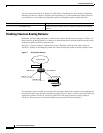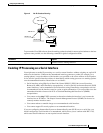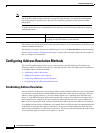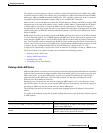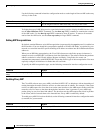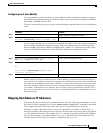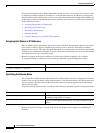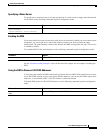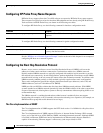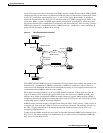
Configuring IP Addressing
Configuring Address Resolution Methods
IPC-12
Cisco IOS IP Configuration Guide
Note Using an unnumbered serial line between different major networks requires special care. If, at each
end of the link, different major networks are assigned to the interfaces you specified as unnumbered,
any routing protocols running across the serial line should be configured to not advertise subnet
information.
To enable IP processing on an unnumbered serial interface, use the following command in interface
configuration mode:
The interface you specify must be the name of another interface in the router that has an IP address, not
another unnumbered interface.
The interface you specify also must be enabled (listed as “up” in the show interfaces command display).
See the “Serial Interfaces Configuration Example” section at the end of this chapter for an example of
how to configure serial interfaces.
Configuring Address Resolution Methods
The Cisco IP implementation allows you to control interface-specific handling of IP addresses by
facilitating address resolution, name services, and other functions. The following sections describe how
to configure address resolution methods:
• Establishing Address Resolution
• Mapping Host Names to IP Addresses
• Configuring HP Probe Proxy Name Requests
• Configuring the Next Hop Resolution Protocol
Establishing Address Resolution
A device in the IP can have both a local address (which uniquely identifies the device on its local segment
or LAN) and a network address (which identifies the network to which the device belongs). The local
address is more properly known as a data link address because it is contained in the data link layer
(Layer 2 of the OSI model) part of the packet header and is read by data-link devices (bridges and all
device interfaces, for example). The more technically inclined person will refer to local addresses as
MAC addresses, because the MAC sublayer within the data link layer processes addresses for the layer.
To communicate with a device on Ethernet, for example, the Cisco IOS software first must determine the
48-bit MAC or local data-link address of that device. The process of determining the local data-link
address from an IP address is called address resolution. The process of determining the IP address from
a local data-link address is called reverse address resolution.
Command Purpose
Router(config-if)# ip unnumbered type number
Enables IP processing on a serial or tunnel interface without
assigning an explicit IP address to the interface.



